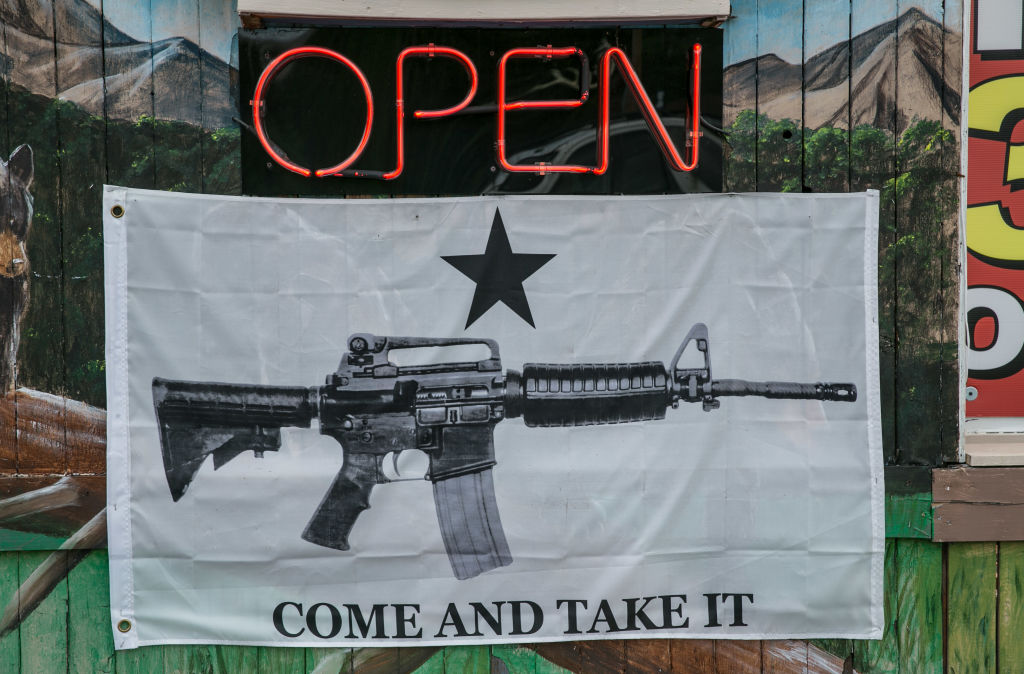The Washington Post gets one thing—if only one thing—right when it comes to the AR-pattern rifle: It is a symbol, and a powerful one.
We should try to understand it in those terms.
In a report published Monday—a generally incompetent one; more on that below—the Post forwards the claim that the AR-type rifle is “overkill for home defense,” which is not really true (and certainly is not a widely held opinion among knowledgeable shooters). But it is overkill for the particular kind of enormity with which the rifle is associated in the minds of many people: massacres such as the one perpetrated Monday at a Presbyterian school in Nashville, Tennessee, in which three 9-year-olds and three unarmed adults were murdered. That is a crime that can be committed with an ordinary revolver, but the role of the black rifle is cultural and aesthetic.
As I have noted here on previous occasions, the AR-type rifle isn’t particularly powerful. It is generally chambered for the 5.56mm NATO cartridge, which is much less powerful than the rounds fired by many common hunting rifles. (The 5.56mm cartridge is, in fact, too small to legally hunt deer with in some states.) Nor is the AR unusual in its rate of fire (it is semiautomatic, meaning that it fires once per pull of the trigger). And it is not unique in its capacity to be outfitted with 30- or 50-round (or 100-round) magazines that can be quickly replaced. Almost any semiautomatic rifle or pistol with a detachable magazine (meaning most firearms) can be similarly outfitted. It is, functionally speaking, just another gun.
Why do so many people prefer such rifles?
There are many practical reasons: The AR-type rifle is an immensely useful tool (particularly for rural pest-control and dispatching predators). Its modest power comes with equally modest recoil that makes it easy and pleasant to shoot. It is highly customizable (which adds both to its practicality and its interest for hobbyists). Ammunition for it is relatively cheap and easy to come by (typically around 70 cents a round, as compared to hunting and precision-shooting rifle rounds that often cost from $4 to $7 a shot and go up from there). And plentiful parts and service make it as easy to maintain and repair as a Honda Civic. But I am not sure that any of that is what matters most.
The AR-15 is cool.
The cool factor of the AR-type rifle comes from a couple of sources.
One is that AR variants are issued to militaries around the world, and there is a reason that little boys play with toy soldiers, a reason that they play with cap guns, and a reason their favorite game is, always and everywhere, war or some version of war. That doesn’t stop when they pass their CPA exams or get married or take out a mortgage, and it probably gets worse for those who don’t get a job, get married, have families, etc.
For marginal men, the desire to identify with warfighters often grows more intense. As the novelist William Gibson once observed: “The windows of Army surplus stores constituted hymns to male powerlessness.” All sorts of items with military pedigrees have made their way into the everyday lives of men (and, to a lesser extent, women) in the modern world—from khaki pants to wristwatches to Jeeps, from fishtail parkas to waxed-canvas backpacks to those aviator sunglasses Joe Biden loves so much, from duct tape to GPS. There’s a reason there are so many motorcycles for sale that are painted army green or desert tan. After 9/11, we had 20 years of warfare in which special forces played an unusually prominent role, and that has left a mark on the American psyche. If the Red Ryder BB gun is an artifact of an America in which little boys dreamed of growing up to be cowboys, then the omnipresent AR-pattern rifle testifies to a world in which the great masculine ideals are SEALs and snipers. SOCOM stands for “Special Operations Command,” but you’ll see that acronym deployed at least as often in firearms-related marketing material as you will in actual military reports.
(Incidentally, I was going to link to a “SOCOM” example above, but I am at the moment working from the cafe of a Whole Foods Market, which apparently employs a digital nanny that blocks U.S. gun-manufacturer websites. The link to the Communist Party of China works just fine. It’s a funny old world.)
The second great source of cool for AR-type rifles is derived from all of those pious and sanctimonious efforts to ban them. After the so-called Assault Weapons Ban expired, sales of such weapons grew orders of magnitude greater than they had been before the ban. Prohibition is a terrific marketing tool: Stamp “Banned in Boston” on a product and watch it fly off the shelves. Making the scary black rifle the powerful cultural symbol it is today has been a collaborative effort between the people who are fascinated by such rifles and embrace them and the people who are fascinated by such rifles and detest them.
Terrorism is expressive and assertive. And without meaning any slight to those who have died in the massacres that afflict our schools and public places, and without minimizing the horror, that is how we should understand these atrocities: as communication.
Terrorism is also the tactic of the weak. Killers who target children in their schools do not pick up semiautomatic rifles patterned after the firearms issued to U.S. soldiers because murdering children requires such weapons. In fact, the deadliest school massacre in U.S. history involved no firearms at all—it was carried out by means of explosives in Michigan in 1927. Our domestic terrorists pick up these weapons because of what the weapons say—or what the killers want them to say: You can hate me and you can fear me, but you cannot ignore me.
There is, in fact, a lexicon of symbolic firearms. The Kalashnikov is countercultural—it is the preferred rifle of commies and jihadists and Third World rabbles—but the AR is red, white, and blue, patriotic, all-American, and, hence, in its political valence, right-wing. As such, it has grown to become associated with right-wing causes and factions as a symbol, including among radicals who see being anti-government as a natural complement to patriotism, if not a necessary and inevitable expression of that patriotism. That radical-fringe credibility has given the AR a certain cachet on radical fringes of other kinds: You can buy a “Trans Rights or Else” T-shirt emblazoned with an AR-style rifle (and several other rifles) on Amazon, which prohibits the sale of books offering unpopular (meaning conservative) opinions about trans issues but apparently makes room for propaganda promising actual armed violence.
Symbolism works in funny ways: At the very moment that we might consider the apex of the 1960s counterculture, the soundtrack was Jimi Hendrix … playing “The Star-Spangled Banner.”
Most newspapers don’t have one person who can write competently about guns. The Washington Post, judging by its latest contribution to the discussion, has no fewer than 21 who can’t. In addition to the 10 staffers credited with creating the visuals, the Post’s report on the rise of the AR-15-style rifle as a symbol credits 21 reporters, editors, and “additional support” staff for the piece headlined, “The gun that divides a nation.”
Naturally, there is a mistake in the first sentence—which is a statement of the piece’s argument in brief: “The AR-15 wasn’t supposed to be a bestseller.”
Of course it was. That is why Colt spent so much money advertising the AR-15 Sporter to the civilian market, targeting hunters, campers, and collectors, well before that rifle’s military cousin became standard-issue for U.S. soldiers. The Post claims that the AR-15 was a rifle of little interest outside of the military until struggling gunmakers discovered a financial opportunity in the paranoid, militarized cultural moment following the terrorist attacks of September 11, 2001, but that gets the timeline all wrong. As a matter of historical fact, Colt was doing its best to sell the AR-15 to civilians way back in the early 1960s, the better part of a decade before the U.S. government finally replaced the old M14 with the military version of the AR-15, the M16. The idea didn’t exactly come out of nowhere: Winchester was selling semiautomatic hunting rifles way back as early as 1903.
It is true that there weren’t a lot of manufacturers offering AR-style rifles for many years after the weapon was introduced. In fact, there was one. Why? As the Post’s 21 reporters and editors note in passing—without quite seeming to understand the point—there were no AR clones on the market at all for some years, because the design was patented. As soon as the main patents expired in 1977, AR-style rifles of varying quality quickly appeared on the market. Some of the big manufacturers began to get into the AR game in earnest in 2005. Why then? Because the so-called Assault Weapons Ban, which specifically prohibited the sale of AR-15 rifles, expired in 2004. The marketplace had been well-leveled.
I have, from time to time, gone through these stories and simply annotated all of the errors in them, but if the Washington Post wants me to help, it’s going to have to pay my regular rate. But I will point to this one, because it is essential to understanding the real historical context of this issue: The 21 reporters and editors of the Washington Post describe the Sandy Hook massacre as the “deadliest mass killing at a K-12 school in U.S. history,” which it most certainly is not. As mentioned above, the deadliest mass killing at a school in the United States happened at Bath, Michigan, in 1927, taking the lives of 38 children and six adults and involved no firearms. (The killer, a failed politician with financial troubles, used explosives.) That brutal mass murder happened many years before the first experimental AR-15 was test fired and more than four decades before the M16 went into standard-issue use.
“Journalism,” the cliché goes, “is the first draft of history.” But the relevant history here is not terribly difficult to track down—it’s right there in the history books. We’re nearly a century past the Bath school massacre and the Washington Post hasn’t heard about it?
Sloppy journalism is irritating under any circumstance, but this is especially vexing because the question at hand—why the AR-style rifle became such a potent cultural symbol—is an interesting and important one. Too interesting and important to be left to the 21 reporters and editors the Washington Post has on the story.
Weapons of war great and small have a way of developing symbolic power—as you can see from the Kalashnikov rifle emblazoned on the flag of Mozambique. Certain liberty-minded Texans still fly the Gonzales flag—that’s the one with the cannon over the words “Come and Take It.” The back story is this: During the reign of Santa Anna, the people of Gonzales had requested and received a cannon from the Mexican government, which later demanded it back, fearful that it would fall into the hands of Texas separatists. The leaders of Gonzales, having been raised in more literate times, referenced the Spartans at Thermopylae, whose response to the Persian demand that they lay down their arms had been “μολὼν λαβέ,” or “molṑn labé” in Roman script, “come and take,” which remains a popular slogan among gun-rights activists.
But there are those among us today who, not having had the benefit of the fine education available to 19th century frontier rustics, have shown themselves less receptive to classical symbols of liberty. Before there was the AR-15, there was David and his slingshot, a biblical image that already had taken on a political character when Michelangelo began working on his famous statue in the first year of the 16th century. A high-school principal in Florida has been dismissed after students were exposed—angels and ministers of grace, defend us!—to a photograph of a statue that originally had been commissioned to decorate a church. Strange thing: Our right-wing populist friends pronounce themselves dedicated to Christianity and liberty, and they turn their grubby little noses up at what may very well be the greatest work of Christian art in the history of the world, one that takes as its subject the holy defiance of tyranny.
There’s irony for you: David, after all these years, still fighting the donkey-souled Philistines.
The theme is liberty: We might consider that images of David performed a role quite similar to that played by images of AR-style rifles in our time—and why settle for what critics dismiss as a mere phallic symbol when you can display the object itself? (David being outfitted, infamously, with the SBR version, for reasons that no doubt made sense to Renaissance critics.) I do not love the fact that AR-type rifles have become cultural totems (I would much prefer it were a Winchester 1886), but there is no denying that it is the case. In the very enjoyable 2011 film version of Coriolanus, which contemporizes the Shakespeare play, it is natural and right that the Romans carry AR-type rifles while the foreign Volscians carry Kalashnikov-style rifles: Romans vs. Volscians, NATO vs. the remnants of the Warsaw Pact, West vs. East, self-styled patriots vs. dirty foreigners—you can see how that works, aesthetically.
Of course, one need not pick a ballistic side: IRA propaganda has featured both AK- and AR-style rifles over the years, along with sundry other scary-looking firearms. (These are not for sale on Amazon.) Glocks have a particular cultural valence for some people, spears for others, Colt Pythons for others. A switchblade is just a pocket knife, but it used to say something about the person who carried it; a Winkler tomahawk says something else entirely.
None of this is particularly unusual or out there. Symbols of war as symbols of politics are as old as war and politics, and even the basics of our political language are borrowed from warfare: “campaigns,” “battleground states,” etc. A “partisan” may belong to a political party or to a paramilitary force.
And so our politics ends up being a kind of ouroboros, a great serpent swallowing its own tail, with a symbolic fight over a rifle that is itself a political symbol. None of this will prevent one drop of blood from being shed, neither in the terrorist spectaculars directed at American schoolchildren nor in the ordinary crime that makes up the vast majority of violence carried out with firearms in this country. To address those problems, we would have to do the much more difficult work of dealing not only with our failed mental-health system and our ineffective criminal-justice system but also with the broader and even more intractable problems implicating cultural decay, marital and family dysfunction. None of these problems is subject to solution by means of statute or by majority vote.
Mock those who offer prayers after these massacres all you like, but a prayer is an admission that something is wrong and that the problem at hand is bigger than quotidian politics, and such a confession seems to me an eminently sensible place to start. If that seems to you a little too metaphysical, then consider that the main alternative on offer is an exorcism—of a symbol, as though nations were conquered by flags rather than by the armies that carry them.









Please note that we at The Dispatch hold ourselves, our work, and our commenters to a higher standard than other places on the internet. We welcome comments that foster genuine debate or discussion—including comments critical of us or our work—but responses that include ad hominem attacks on fellow Dispatch members or are intended to stoke fear and anger may be moderated.